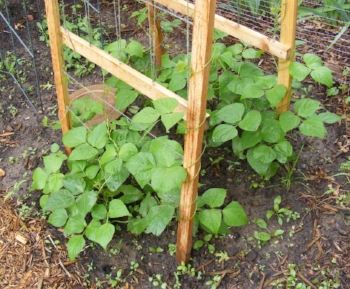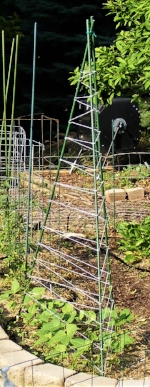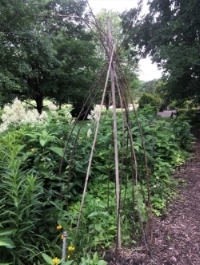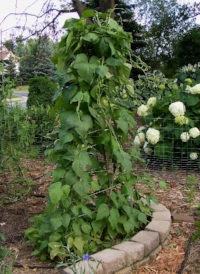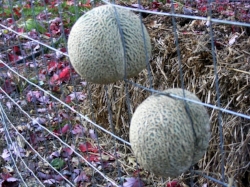Trellising Vines
SELECTING A TRELLISING METHOD
It seems so simple, but is it really?
But there are so many nice advantages to trellising plants even when they don't really NEED it.
Vertical growing saves garden space
A trellis provides shade for crops that need it
Tall structures add interest to the garden
Vegetables are kept clean and prevents the "ground spot"
Harvest is easier
As for the shape, structure and materials for a trellis, I love natural looking materials if possible and interesting shapes such as hoops, arches and teepees. Although sometimes just buying something easy is labor and stress free, in which case I like to select something colorful at the least.
Storage space was always an issue for me so I have made my own and got creative. I have attached a large piece of chicken wire between two chunky wooden stakes and just rolled them up to store in winter. I also built my own fold-flat pea and bean trellises from cedar and twine. I loved them and so did the peas and beans, but it did take quite a lot of time and ongoing maintenance. Set your own priorities considering your labor time, storage space, cost limitations and growing needs.
VINING TYPES
This is a very important consideration when selecting a trellis method is "how does the plant climb?"
Winding
Pole beans love to wind their vine around anything they can grab hold of. They are not fussy at all about the material or structure, they will wind around anything vertical. The taller the better as a pole bean likes to grow and grow and grow. You may want to tip prune vines that reach the top of the trellis.
Rambling
Indeterminate Tomato vines and Sweet Potato Vines do not naturally climb. The vines will just scramble across or downward from their growing position. If allowed to ramble they will expend energy into rooting to the ground. These vines need to be tied up and trained to grow upward so that they focus energy on fruit production.
Tendrils
Peas, cucumbers and some squash produce tendrils that will reach for and grab hold of something vertically or horizontally. They typically prefer natural materials which are somewhat rough and gritty compared to smooth metals. My cucumbers will climb a metal fence, but peas are more difficult. With much encouragement and tying the peas will eventually take hold of certain metals but many of the vines end up grabbing hold of a tied vine.
MATERIALS
Be creative in selecting materials for your trellis. You can't go wrong with natural materials and re-purposed items. Supports of bamboo or wood with fencing, netting or twine are fairly standard. Even for peas that don't like metals you can use metal stakes with twine laced between them. A piece of wood lattice is an easy solution, looks good and most vines (except tomatoes) will climb it easily. I also love large fallen tree limbs lashed together like a teepee with twine lacing.
Re-purposed items are always fun to use. Old iron headboards, discarded bicycle frames, gates and fence sections add creative interest to the garden and can be colorfully painted for added pizzazz. An old swing set is an excellent item to recycle into a trellis system that can accommodate tall vines, heavy fruits, or even several fruiting and flowering varieties all at once. A neighbor once grew vines on a gazebo frame that created a shaded garden room for lounging out of fruit, vegetable and flowering vines.
STRUCTURE
Whether you purchase, re-purpose or build your trellis it is imperative that you consider the weight of the fruits. Many things we grow don't produce much for weight on a trellis but may still require good anchoring. And don't forget about the birds that will perch on top!
Melons of course will need a very sturdy structure to support a lot of weight. But heavy fruits can also topple over a flat trellis. It is best to use a 3 or more leg structure that is deeply anchored into the ground. Even beans or flowering vines can weave a dense mat on a trellis which increases the likelihood of it being blown over in the wind.
For just about any vining plant I rather like the large hoop structures. They can be made lightweight with minimal support or very heavy duty with good structural supports for melons. The hoop also creates some shade for growing lettuce and cool season vegetables.
For the sturdiest of structures you should be using something along the lines of T posts (you know those heavy duty steel garden posts with fencing hooks) and Hog Panel (super heavy duty fencing). These are actually very easy materials to work with and can be taken down for winter, reinstalled each spring and will last virtually forever.
Lighter weight garden posts and tied twine in a number of different configurations are also easy to work with, but the twine will need to be replaced or retied each season.
Flat panel trellises can be fixed to a fence, shed wall, even a tree, to prevent being blowing over.
A final note about supporting melons: Large melons are just plain too heavy for any structure and are heavy enough to damage the vines if trellised up. Large melon vines should be allowed plenty of room to ramble on the ground.
ORIENTATION
This is very often forgotten when planning a trellis. The way the structure is oriented to the sun will affect the amount of direct sunlight all sides of the trellis will receive. It will also affect shade cast on your garden at different times of day. Creating shade for certain plants through the heat of the day can be a bonus when properly planned. North to South trellis is usually ideal for the vining edibles and also creates a nice afternoon shade on the east side.
If you are erecting several parallel trellises, be sure to space them far enough apart to give all the vines good sun exposure. That will also allow space for the foliage as well as space for the gardener to tend and harvest!
